JULY 10, 2025 | FREE
Real estate agent exploring restaurant incubator
So That Reminds Me: Springfield Jazz & Roots Festival
On the latest episode of “So That Reminds Me” Kristen Neville, Blues to Green executive director, sat down with hosts Dennis Hackett and Lauren LeBel to talk all about the upcoming Springfield Jazz & Roots Festival that takes place on July 11 and 12.
DCAMM accepting bids for new Springfield courthouse
The state’s Division of Capital Asset Management and Maintenance has officially posted its requests for proposals for the future Springfield Regional Justice Center project. SEE PAGE 3
Springfield among those suing Trump admin over EPA grants
The fight for clean air continues as Springfield is one of many listed in a lawsuit against the Trump administration for the president’s recent termination of Environmental Protection Agency grants. SEE PAGE 4
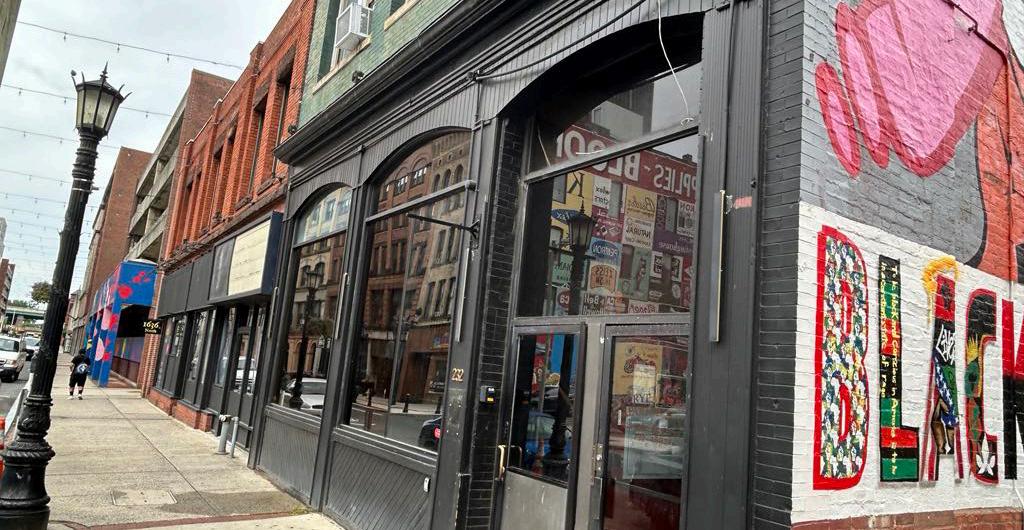
By Ryan Feyre rfeyre@thereminder.com
SPRINGFIELD — The owner of 232 Worthington St., which formerly housed Dewey’s Jazz Lounge, is seeking to create a restaurant incubator at the location for aspiring entrepreneurs looking to “launch and grow their culinary businesses.”
Rubicon Holdings LLC, which purchased the property in 2019, is exploring the possibility of creating an incubator with shared kitchen space, business mentorship programs, access to resources and a collaborative community.
The project aims to “nurture and accelerate” the growth
of emerging culinary entrepreneurs, along with those wishing to work within the restaurant and hospitality industry, according to Rubicon.
“The launch of the Springfield Culinary Incubator is anticipated to be a powerful catalyst for economic development, generating numerous employment opportunities within the local food sector and beyond,” Rubicon said in its announcement. “It is expected to inject fresh vibrancy and diversity into the city’s culinary landscape, offering residents and visitors an expanded range of dining options and innovative food products.”
Alfredo Orejuela, a manager of Rubicon, said in an interview
that a survey has been released to the public to gauge interest on the new incubator plan and to find out what prospective operators may need for resources.
He said the incubator would welcome aspiring chefs or caterers, food truck operators considering a brick-and-mortar, individuals with a unique food concept, or anyone interested in the business side of the restaurant industry.
The survey, available in a couple different languages, will likely be up until mid-August, Orejuela said.
“The main thing would be figuring out how many people are interested so that we can tailor our
initial programming to that and for grant applications, for equipment and capacity needs,” Orejuela said of the survey. “That’s why we’re asking people that are potentially thinking of any of these programs, ‘what type of business are you? What equipment do you need? What programs are you interested in doing?’ Because that’s really going to help us a lot in terms of crafting and purchasing that equipment.”
In dealing with commercial properties on a daily basis, Orejuela said he has noticed that restaurant operators need a lot

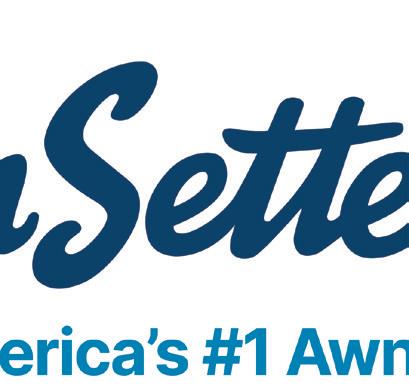


So That Reminds Me: Springfield Jazz & Roots Festival
By Tyler Garnet tgarnet@thereminder.com
On the latest episode of “So That Reminds Me” Kristen Neville, Blues to Green executive director, sat down with hosts Dennis Hackett and Lauren LeBel to talk all about the upcoming Springfield Jazz & Roots Festival that takes place on July 11 and 12.
This year marks the 12th annual Springfield Jazz & Roots Festival, which Neville described as an event that “draws people from diverse cultural and socioeconomic background together for performances of jazz, blues, Afro-Caribbean, funk and global roots artists.”
Some of this year’s headliners include Endea Owens and the Cookout, El Laberinto del Coco and Merging Roots.
There is a recommended ticket donation for the indoor performances. The proceeds help support the festival and organization.
“We try to have this be as accessible as possible so people of all walks of life can attend and have access to incredible music and arts experiences, so those who have the means to make a donation helps just keep it accessible and keep it going and enable us to do it year after year,” Neville stated.
There will also be local performers, arts vendors, local food vendors and family art activities in downtown Springfield centered around Stearns Square.
The festival will also feature an indoor venue with programming at the new Hope Center for the Arts, formerly CityStage, at 150 Bridge St.
“So, we’ll have programming indoors at that center throughout the day so people can move throughout the area from Stearns Square through Tower Square Park and over to the Hope Arts Center,” Neville said.
Brew
Neville explained that the creation of this event was due to being married into a musical family from New Orleans who toured around the country and the world for many years. Neville is the wife of the late Charles Neville, who performed with his siblings as the famed R&B group, the Neville Brothers.
After returning to her native Western Massachusetts, Neville said she wanted to start an organization that uses music and the arts to bring people together and help promote positive environmental and social change.
She connected with other people in the Springfield area already working in the arts who were interested in bringing a festival back to the downtown area.
The nonprofit Blues to Green was created and was inspired by the life and music of Charles Neville.
The first Springfield Jazz & Roots Festival was hosted in 2014 and Neville said it has been going “strong” ever since.
She also talked about how the festival has grown and said the festival was hosted at Court Square through 2019 and was virtual in 2020.
When the festival took place again in-person, it was relocated to the Stearns Square area.
Over the years, the festival has evolved from one stage to two stages and now has an indoor venue as well for programming and nighttime performances.
Neville said The Hope Center for the Arts will provide different opportunities and called it a “stateof-the-art facility.”
The center installed a new sound system, a large screen behind the stage and various studio spaces for arts and video production.
“We’re trying to spotlight what that center has to offer so we have an immersive, art, tech, experience with this band coming from New
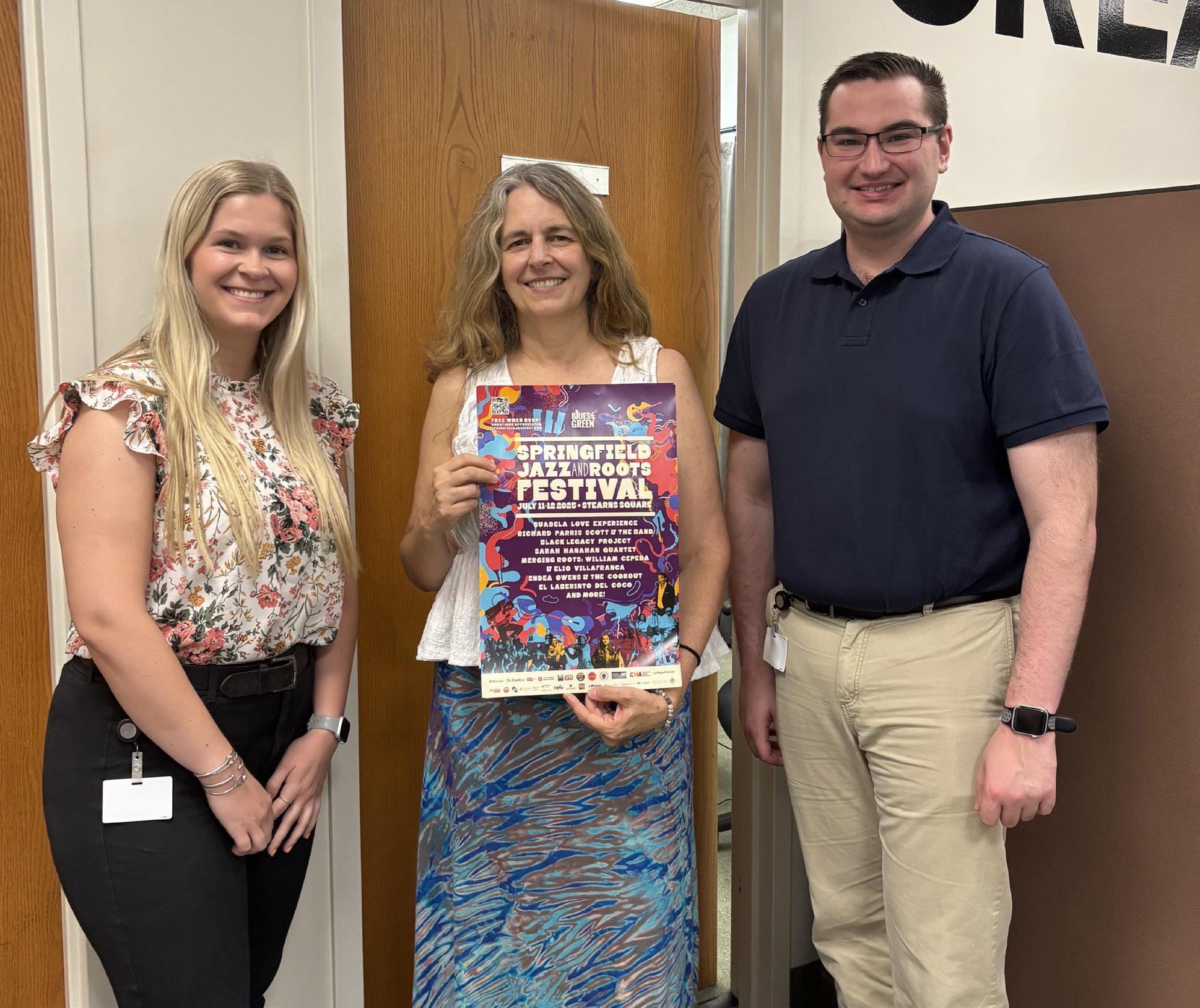
Orleans so that should be pretty cool with the music and visuals and some other things that we have brewing for that space.”
Neville also talked about how the new location benefits not only her organization but also the city. She said, “We were able to integrate the festival more with the surrounding businesses and support them by drawing visitors right to their front door.”
Blues to Green also recently started a new program called the
Legacy Education Project which was inspired by Charles Neville, who died in 2018.
“The idea for this program was to bring various artists whom have performed at the festival into the public schools for residencies — which are usually three days — and they’re artists of African and Caribbean descent who shared their life stories and lived experiences and their cultures and music and they’re sort of role models for these young people whose own
families and communities reflect these artists or vice versa and be able to see themselves reflected in these artists that they can do this,” Neville explained.
For more information about the upcoming festival or about the organization, readers can visit bluestogreen.org.
To hear the full conversation, head to thereminder.com/our-podcast or search for “So That Reminds Me” on your favorite podcasting platform.
at The Zoo fundraiser brings 20+ breweries to Forest Park
SPRINGFIELD — The Zoo in Forest Park’s seventh annual Brew at The Zoo, presented by PeoplesBank, is set for Saturday, Aug. 2, from 1:30-5 p.m.
Brew at The Zoo is The Zoo’s largest fundraiser of the year, raising money in support of The Zoo’s mission to inspire the community to respect and value the natural world through education, conservation and rehabilitation. This event includes beer samples from over 20 breweries, food trucks, live music, a raffle and a chance to visit with The Zoo’s
Incubator
of support to make their business successful. He shared that
200+ animals.
“With the combination of beer and animals, it’s no surprise that Brew at The Zoo has become our most anticipated event of the year,” said Gabry Tyson, assistant executive director of The Zoo in Forest Park. “We have both guests and vendors that return to brew year after year.”
One of these reoccurring vendors is Abandoned Building Brewery in Easthampton.
“We have been coming to Brew at The Zoo for three years now,” said Braeden Dion, sales
his restaurant industry tenants usually reside in three buckets: a novice who has an idea for a restaurant, an industry veteran who wants to get their idea off the ground and a seasoned entrepre-
manager at Abandoned Building Brewery. “It’s a well-run event, and the Homebrew Competition is a great addition to the fest. So many friendly faces and great people make this an event that Abandoned Building Brewery wouldn’t miss.”
Michael and Kerry Kennedy, a husband-wife team that run Beerfort Brewing in Agawam, have been participating in Brew at The Zoo’s Homebrew Competition — a portion of the event in which attendees and professional brewers vote on their favorite home brew
neur that knows the ins and outs of the restaurant business.
As the industry continues to recover from the coronavirus pandemic, Orejuela said an incubator space would help these

— since 2023. Last year, they were awarded People’s Choice for their blueberry shandy.
“What sets Brew at The Zoo apart from other brew fests is the atmosphere,” said Michael Kennedy. “We are surrounded by animals and keepers introducing those animals to the crowd while we pour beer — that’s amazing! My favorite event of the year.”
A limited number of VIP tickets are available, which include extra time to sample the beer, as well as interactive animal encounters and keeper talks with mem-
operators nurture their business before they potentially open their own restaurant.
“We see this as a catalyst opportunity where we can bring operators that fit into one of those three buckets and help them through the process of establishing their identity in the dining district there on Worthington Street, and really in Springfield in general,” Orejuela said.
According to Rubicon’s survey announcement, the incubator would provide a wide array of shared resources, including storage, packaging equipment and administrative support.
In addition to the shared kitchen space, the location would likely include an event space for artists and a “robust” mentorship program run by seasoned industry experts who will guide “all facets of business development.”
“This incubator would allow operators to try out their concepts in a downtown environment, in a high traffic area, for a fraction of cost that would be associated with doing it themselves,” Orejuela said. “It would allow multiple operators to test their concepts out over the course of the year and refine them and get them ready to be a minimum viable product that they can actually then take to the market.”
Dewey’s Jazz Lounge used to be a tenant at 232 Worthington St. before the business closed its doors in April. The business operated out of the space for almost
bers of The Zoo’s animal care and education teams. The VIP time slot runs from noon to 1:30 p.m. and tickets are limited.
The Zoo will be closed to the public for this ticketed event on Aug. 2. Advance tickets are required, and all IDs will be checked at the door. No one under 21 will be admitted. For a list of participating breweries and to purchase tickets, visit forestparkzoo.org/brew.
For more information, contact Tyson at 413-733-2251, ext. 925, or gabry@forestparkzoo.com.
four years.
In a Facebook message on April 9, Dewey’s owner Kenny Lumpkin said the decision was not made by them, and “was not made lightly.”
The restaurant also said on their Instagram that the closure is due to “circumstances beyond our control.”
“We hosted unforgettable performances, uplifted local talent and brought people together in ways that made a lasting impact,” Lumpkin said. “I am deeply proud of the role we played in contributing to the life and energy of downtown.”
On April 23, the License Commission gave Lumpkin three extra months to come back with a status update on the now dormant liquor license. The goal of the extension was to allow Lumpkin more time to find a new space for the lounge.
As for the incubator plans at 232 Worthington St., Orejuela said he wants to keep the interest survey open until at least August. After that, a working committee will form to help develop some of the programs for the new incubator.
The plan is to hopefully have a newly renovated space open by mid-August, according to Orejuela.
Readers interested in providing opinions about the future space can follow the survey link: tinyurl.com/mu9nt396.
DCAMM accepting bids for new Springfield courthouse
By Ryan Feyre rfeyre@thereminder.com
SPRINGFIELD — The state’s Division of Capital Asset Management and Maintenance has officially posted its requests for proposals for the future Springfield Regional Justice Center project.
Officially released on June 30, the RFP gives bidders a little over three months to submit proposals to build a new courthouse in Springfield, which will be leased by the Massachusetts Trial Court for an initial term of 40 years and a maximum term of 60 years.
According to the RFP, DCAMM seeks approximately 244,000 square feet of usable area in Springfield for the courthouse, but the organization would consider space of 220,000 to 300,000 square feet.
Additionally, the RFP states that the usable area must be within a half mile of public transportation.
“The commonwealth’s objective is to lease space that aligns with the commonwealth’s goals and policy objectives and that is most advantageous to the commonwealth’s needs for the best value,” the RFP says.
DCAMM’s request comes a few weeks after the HealeyDriscoll administration hired Greystone Real Estate Advisory Group to lead the procurement process for the new courthouse project.
According to the announcement sent by the state, “Greystone will provide strategic guid-
ance, evaluation support and negotiation assistance throughout the project, which will contribute to efforts by the Division of Capital Asset Management and the Executive Office of the Trial Court to solicit proposals that meet the priorities stakeholders have expressed.”
“The Healey-Driscoll administration is committed to building a new Springfield Courthouse that meets the needs of the community and the court as expeditiously as possible,” said DCAMM Commissioner Adam Baacke.
“DCAMM is pleased to enlist a firm with Greystone’s extensive experience and track record to support this solicitation.”
According to the state, Greystone has been providing commercial real estate service to public, private and not for profit clients since 1999. Their website states that the organization is the “nation’s leader in the management of revenue-producing properties for public transportation agencies.”
“The Trial Court is committed to working closely with DCAMM to ensure the successful delivery of a courthouse that meets the needs of the Springfield community and advances the important work of the justice system,” said Court Administrator Thomas Ambrosino in response to the hiring. “We support DCAMM’s efforts to make the procurement process as transparent and competitive as possible.”
As for the RFP, bidders must submit their proposals on the

DCAMM Lease Proposal Form included within the RFP, and can do so by mail, messenger service, in-person or electronically.
Eligible bidders must be the record owner of the proposed property, a tenant of the proposed property whose lease permits subleasing, or the prospective purchaser or a prospective ground tenant of the proposed property whose lease permits subleasing.
The RFP includes other requirements, as well.
“Proposals will be evaluated according to the evaluation criteria, incorporating information within the proposals themselves,
insights gathered for site visits, clarifications sought from proposers upon request, and references provided by the proposers,” the RFP says. “Furthermore, the evaluation process may encompass data from state agencies, individuals, and entities possessing relevant knowledge, as well as insights from commonwealth files and other credible sources.”
Readers can learn more about the RFP and its accompanying documents by visiting its link: tinyurl.com/4dewvr5u. More coverage on the new courthouse is found here: tinyurl. com/yc44utdp.
Springfield celebrates opening of first public skate, bike park
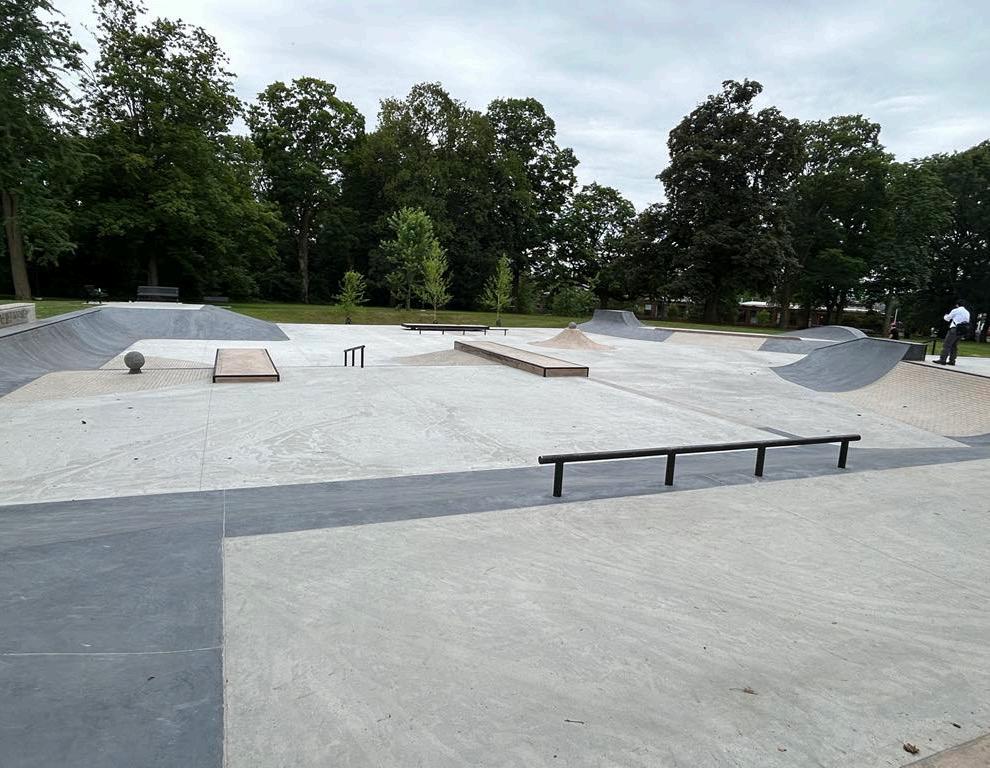
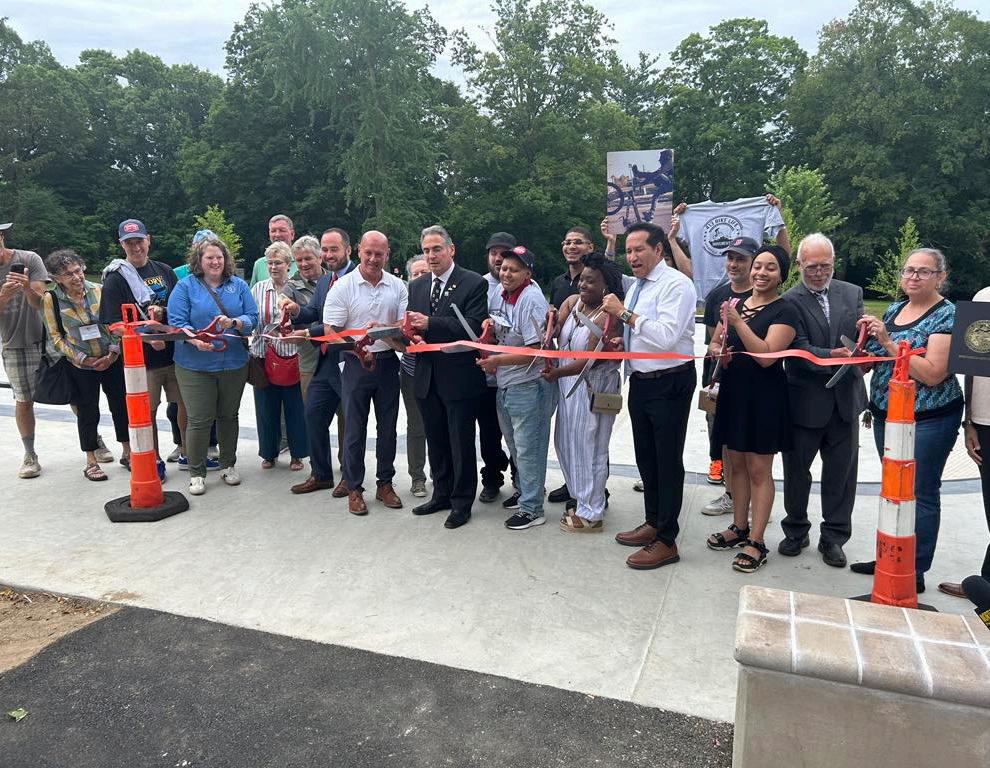
By Ryan Feyre rfeyre@thereminder.com
SPRINGFIELD — Louis Sacco of 413 BikeLife remembers the days before 2017 when his group of friends would get into trouble for riding their bikes in the streets and in city parks.
“We’d get kicked out of certain places for riding our bikes and skateboards,” Sacco told Reminder Publishing in an interview. “It was just like, ‘well, you don’t want us to ride in the streets, you don’t want us to ride in the parks … where do you want us to go.’”
Thankfully, for Sacco and other riders, that question has finally been answered for them. Following years of advocacy, Springfield’s first and only public bike and skate park is now open to the public.
Riders from all over were already performing tricks across the 12,000-square-foot pit at Gurdon Bill Park as advocates gathered with city and state officials on June 23 to celebrate the completion of the $2 million project.
According to Mayor Domenic Sarno, the new bike and skate park was funded by a $1 million National Park Service Land & Water Conservation Fund grant funneled through the state, as well as a $1 million contribution on the city side.
Additionally, an $80,000 grant from the Community Preservation Act funded the study and initial design of the project following the Springfield Park Commission’s approval of a feasibility study to determine the location of the project.
Sarno said in his remarks that the Gurdon Bill Park bike and
skate park is one of many projects throughout the city that prioritizes youth development. He shared that there have been $1 billion worth of newly built and rehabilitated schools, as well as $110 million invested in the parks system.
“I think this will be a huge benefit for the neighborhood, especially our young people,” Sarno said of the new park. “And their parents and grandparents can come out here too.”
The path to get to this point was long and challenging, but nonetheless, rewarding. Although advocacy for a bike and skate park stretches back decades, a formal push for the park gained steam in 2017 thanks to the work of Metro Center Association President Betsy Johnson, RADSpringfield founder Alex Weck and Community Preservation Committee member Yolanda Cancel.
According to previous Reminder Publishing reporting, the three community members spearheaded the request late last decade after citing a need for a recreational space in Springfield where youths could safely enjoy bike and skateboard activities.
Bumps in the road occurred throughout the last several years, including a few misunderstandings and false starts (tinyurl.com/ 54jmjadr), but the result of these challenges is an all-encompassing recreational space that includes not only the skate park, but also splash pads and swings.
“It starts with a conversation and ends with a solution,” Cancel said. “When the mayor understood that 413 BikeLife wasn’t motorcy-
cles, that it was a non-motorized wheel park … he’s like, ‘oh, now we can do that.’”
Cancel’s leadership and advocacy throughout the process rang throughout the corridors of Gurdon Bill Park, to the point where state Rep. Carlos Gonzalez (D-Springfield) suggested that the new bike and skate park be named after her.
“It was Yolanda Cancel that made the call, screamed, spoke about it, met about it, yelled about it, galvanized it,” Gonzalez said. “And her team out of the south end at that time really took initiative to embrace this initiative on behalf of our kids.”
According to Department of Capital Asset Constriction Director Pete Garvey, the city worked with GZA contractors for the park design, Mass. West Construction for the building of the park and Pillar Design Studio for other design elements.
The city said the park can be used for wheeled recreation like skateboards, BMX bikes, roller skates, scooters, wheelchairs and other accessibility equipment.
For community activists like Cancel and Sacco, the sight is now a welcome one, especially after years of underutilization and what Gonzalez described as “bad activities” at Gurdon Bill.
“When we first walked this park in 2018 … it was so empty, underutilized and dark,” Cancel said. “This [bike and skate park] is not only a plus for Lower Liberty Heights, but for everybody in the community.”
The impact of the new park is already being felt. Cancel said
that people from as far away as Worcester have already visited to enjoy the new amenities. Others from Westfield, meanwhile, have already asked her how Springfield built the park so they can do it in their own community.
In Sacco’s case, the new amenities yield a sea of emotions.
The 413 BikeLife member recalls how the group was created to keep youth away from violence following the death of a couple friends.
He said he wishes they were here to see the new park, but he’s nonetheless excited to see how future generations — including his own kids — react to it.
“I’m holding back emotions as best I can … because there’s a lot of kids that should have been able to see this,” Sacco said. “Me, I’m a father now, so now I can bring my kids here. It’s a safe place for them to ride their bikes and run around and just have fun without having to worry about getting kicked out.”
Roxanne Miller-Longtin, Evan Marcyoniak, Katerina Lopez
Sales Support: Carolyn Napolitan
Financial Department: Nancy Banning
Springfield among those suing Trump admin over EPA grants
By Ryan Feyre rfeyre@thereminder.com
SPRINGFIELD The fight for clean air continues as Springfield is one of many listed in a lawsuit against the Trump administration for the president’s recent termination of Environmental Protection Agency grants.
The city joined several other nonprofits, tribes and local governments in suing the administration for what they say is an unlawful termination of the EPA’s Environmental and Climate Justice Grant programs “despite a congressional directive to fund them.”
Earthjustice, Southern Environmental Law Center, the Public Rights Project, and Lawyers for Good Government filed the challenge on behalf of ECJ grant recipients to seek the restoration of the nationwide program and to require the reinstatement of awarded grant agreements, according to a press release from Earthjustice.
The 23 plaintiffs involved in the lawsuit are seeking to restore the $3 billion that was promised to “community-driven” projects across the country. EPA Administrator Lee Zeldin is the defendant in the case.
According to court documents, the case is being taken up at the U.S. District Court level.
“EPA’s termination of the program is unlawful,” the lawsuit reads. “It violates bedrock separation-of-powers principles by effectively repealing a congressional enactment and impounding funds based on nothing more than the President’s disagreement with policies Congress duly enacted.”
The Environmental and Climate Justice Program was created by former President Joe Biden’s Inflation Reduction Act under Clean Air Act Section 138 to award $3 billion in grants to community-based nonprofits, according to Earthjustice.
Springfield was supposed to receive $20 million of that mon-
ey to fund a community solar project, complete home rehabilitation projects, plant 1,500 trees throughout the city and retrofit 30 one-to-four-unit homes to improve indoor air quality.
Additionally, the money would support a workforce development program for HVAC-R technicians and convert two city-owned buildings to non-grid clean energy sources while expanding their use as community resilience hubs and emergency shelter locations.
According to Springfield City Solicitor Stephen Buoniconti, Springfield was the only community in the state to receive such an award.
But that money and other grants were eliminated across the country in early 2025 as part of Trump’s efforts to downsize the role of the federal government in energy and environmental spaces.
“The city of Springfield was left with no recourse but to sue the federal government
to enforce the $20 million EPA grant,” said Buoniconti. “We are pleased to partner with … the Public Rights Council and others in filing the lawsuit to recover the grant monies.”
According to the lawsuit, the plaintiffs are seeking class action certification and preliminary relief so that all 350 grant recipients harmed by the termination can continue their “community-based initiatives.”
Buoniconti said the Public Rights Project is representing Springfield “at no cost to the taxpayer.”
“Unlawfully ending this program threatens the ability of local governments to protect their people and the environment,” said Jon Miller, chief program officer for the Public Rights Project. “This case isn’t just about restoring grant funding in a handful of places — it’s about restoring critical services and projects in areas of the country with the greatest need.”
In Springfield’s case, the
elimination of this money would likely be a lethal blow to a city that was dubbed the “asthma capital of the country” in 2019, according to the Asthma and Allergy Foundation of America, and was named the fourth most challenging place to live with asthma as of 2024.
Furthermore, Springfield also lost out on a $1 million grant from EPA for asthma prevention support, and the City Council is currently appealing a recent ruling by the Massachusetts Appeals Court that gives more life to a controversial biomass plant proposal by Palmer Renewable Energy: tinyurl.com/54ad2896.
Despite the dour outlook, Buoniconti remains optimistic about retaining the EPA money.
“Gradual improvements have been made to asthma and lead exposure rates and the grant will benefit the health of every resident of the city,” Buoniconti said. “We are optimistic that the Public Rights Council will best represent the city’s interests.”
Springfield Cultural Partnership receives placemaking grant
SPRINGFIELD Springfield Cultural Partnership recently announced that it has been selected by Project for Public Spaces, in partnership with CultureHouse, to receive a Community Placemaking Grant: Civic Spaces to create an indoor pop-up space in Springfield to foster community connection and civic engagement. Thanks to support from Robert Wood Johnson Foundation, as one of two grant recipients, the Partnership will receive $60,000 in direct funding, as well as planning, implementation, and capacity building assistance from Project for Public Spaces and CultureHouse.
The Springfield Cultural Partnership, a nonprofit dedicated to civic engagement through the arts, serves the culturally diverse community of Springfield, particularly Black and Latinx residents, by fostering connection, cre-
ativity and action. With support from this Community Placemaking Grant, the Partnership will transform a vacant space that is street-level and faces Main Street at the Tower Square business center in Springfield, into a free, accessible space for artists and residents to gather, create art, and engage in civic programming. The project will demonstrate how the arts can drive public dialogue, community organizing and local change.
“When we make space for creativity, community, and connection, we pave the way for possibility, joy, and the kind of inspiration that emerges when artists and neighbors come together to co-create a vibrant, connected future,” said Karen Finn, Springfield Cultural Partnership’s executive director. “By centering artists in civic life, we’re fostering inclusive, community-driven
environments where residents can connect, lead, and take part in organizing around the issues that matter most. Equitable access to creative, cultural, and civic space is not just a benefit, it’s a powerful tool for transformation. The Springfield Cultural Partnership is honored to walk alongside the artists, youth, and community leaders shaping this vision with their care and brilliance.”
Many BIPOC and low-income communities across the United States lack access to dedicated civic spaces where community residents can come together to organize, engage in dialogue and address local challenges. This deficiency in civic infrastructure hampers efforts to cultivate community leadership, strengthen social cohesion, confront systemic inequalities and hold government officials accountable. To help bridge this critical gap, Project
for Public Spaces’ Community Placemaking Grants: Civic Spaces will assist the two organizations over an 18-month period to identify locations for their pop-up indoor spaces that suit their goals, implement three months of programming and learn to manage these spaces as well as promote long-term civic engagement.
“A really successful civic space is not only a place where the community can feel welcome. It’s where they can connect with each other, safely organize and tackle local problems together,” said Elena Madison, Project for Public Spaces’ director of projects. “We are looking forward to building these vibrant pop-up civic spaces with grantees and their communities so they can strengthen their social ties to one another and advocate for change.”
“The power of pop-ups is that they meet people where they
are — and show what’s possible when communities lead the way to create livable, joyful and connected neighborhoods,” said Afsar Yassai, CultureHouse’s community manager. “We’re excited to support these grantees through the pop-up process as they turn underused spaces into centers for civic connection, ensuring that community ownership is prioritized as neighborhoods evolve.”
The Project for Public Spaces and CultureHouse teams will work with grantees to organize visioning sessions with their respective communities, before choosing a site for activation, conceptualizing an activation plan, designing, construction, and implementing programming. Pop-ups are expected to run for three months sometime between November 2025 and May 2026.
White Lion Brewing reactivates outdoor space at Tower Square Park
SPRINGFIELD — In May 2023, Springfield Mayor Domenic Sarno announced American Rescue Plan Act awards to businesses looking to significantly improve outdoor dining and event space in the city of Springfield.
White Lion, an ARPA award recipient, was tasked to reactivate Tower Square Park as a unique event space. The park is centered in the heart of the downtown business and evolving arts district. On July 9, White Lion introduced Pridelands on Mane Street, Downtown Springfield’s new outdoor event destination. This unique space, created from three custom-designed shipping containers, offers an unforgettable backdrop for company
outings, team socials, or casual get-togethers with friends and family. Featuring a food and beverage container, open-air lounge, and dedicated music zone, Pridelands is the place to relax, connect and celebrate. Pridelands will offer weekly entertainment on Wednesday and Thursday evening, special theme nights and events, and a
food residency initiative that offers a local food business an opportunity to showcase its brand and offerings.
White Lion President Ray Berry said, “We are a family friendly brewery and a community connector that looks to bridge gaps, enhance relationships and be supportive within the region’s creative economy.
“Though times are different post-COVID, Pridelands looks to establish a new lane of activation that we hope encourages people to not only support White Lion, but downtown as a whole. There are so many positive moving parts to engage and enjoy; we see Pridelands as another piece of that mosaic,” he continued.
Addiction Taskforce highlights local innovations in addiction recovery
SPRINGFIELD — The Hampden County Addiction Taskforce, a regional collaborative dedicated to combating substance use disorder through coordinated prevention and treatment efforts founded by the Hampden District Attorney’s Office and Hampden County Sheriff’s Office, hosted its latest meeting on June 11, featuring two presentations from emerging leaders in recovery care. New Growth Recovery, a newly launched day treatment program in downtown Springfield was introduced by Co-founder Evan Plomaritis. Located at 1350 Main St., Suite 1500, New Growth Recovery offers structured, evidence-based care with a focus on individualized, holistic support for those facing substance use disorders. The
program integrates medical, therapeutic and peer-driven services, with options for both full-day and partial-day care.
Plomaritis emphasized the organization’s commitment to fostering community integration, reducing barriers to care, and creating a culture where staff well-being directly enhances client recovery. Clinical Director Dr. Matthew Donlan and

TheReminder.com
Every week we will provide you with a complete listings of deaths from the preceding week from throughout Greater Springfield. We are doing this as a convenience to our readers in case you miss an obit in the daily paper. We hope you find this useful and that you will refer to it weekly.
CHICOPEE
Dolores R. Arcott
Lorraine A. Champagne
John J. Czerapowicz
Wayne R. Myslinski
HOLYOKE
Robert F. Boardway Jr.
Fredrick G. Cooper
James Joseph Gaunt
Henry G. Seidel
Patricia C. Welch LONGMEADOW
Frieda Ramaswamy
Ahmad Saremi
SOUTH HADLEY
Dawn Berard
Margaret M. Breault
SPRINGFIELD
Marilou Chenaille (McConville)
Jennifer E. Fitzpatrick
Carole Jean Jonaitis
Louis Kerlinsky
Phyllis Morin
Dorothy F. Sowa
WILBRAHAM
Judith Morrison
Mary Corinne
Stark
Myron F. Stone
Program Director Emily Hescock lead a team of experienced clinicians and case managers dedicated to long-term success through personalized recovery planning. Also presenting was Alisha Kumar, community outreach coordinator for the Springfield Comprehensive Treatment Center. Kumar provided an overview of the CTC’s outpatient medication-assisted treatment programs, which serve adults aged 18 and older. CTC offers FDA-approved medications such as methadone and Suboxone paired with individual and group counseling, all tailored to meet the specific needs and goals of each patient. In addition to core treatment services, CTC participates in the State Opioid Response program, providing a wide range of voluntary support services, from transportation and housing resources to harm reduction supplies and employment assistance. With extended hours and multiple sites across Massachusetts, CTC remains a crucial access point for individuals seeking recovery. Both organizations are actively working to strengthen local partnerships and coordinate with HCAT members to ensure a seamless continuum of care.
EMERSON COLLEGE DEAN’S LIST
BOSTON — Mayalan Alameh and Jayden Lopez of Springfield were named to Emerson College’s Dean’s List for the spring 2025 semester. To make the dean’s list, students must have a grade point average of 3.7 or higher for that semester.

Springfield secures $5M for HVAC upgrades at Glickman
By Ryan Feyre rfeyre@thereminder.com
SPRINGFIELD — Alfred Glickman Elementary School is the latest in Springfield to receive necessary upgrades to its heating, ventilation and air conditioning systems.
The city received $5 million from the Massachusetts Clean Energy Center’s Green School Works program to install air source heat pumps and ventilation upgrades at the Ashland Avenue school.
“These upgrades are critical to school operations,” said Parks, Buildings, and Recreation Management Director Thomas Ashe. “We believe that buildings with ideal conditioning support overall academic achievement as well as day-to-day attendance rate improvements.”
Glickman was one of 18 Massachusetts schools to receive money for upgrades from MassCEC. The organization awarded a total of $52 million through its Green School Works program, which “aims to make K–12 public school buildings more energy-efficient, lower costs for school districts, reduce pollution, and create safer and healthier learning environments for students and educators.”
The program was funded by the Department of Elementary and Secondary Education, according to MassCEC.
Ideally, Ashe told Reminder Publishing that the city wants to complete the HVAC upgrades at Glickman during summer va-
SPRINGFIELD — When Maria Renta-Marrero enrolled at Springfield Technical Community College, she didn’t expect two elective courses — Federal Income Tax and Bookkeeping — to spark a career transformation.
Born in Puerto Rico, Renta-Marrero is a Springfield resident and mother of two. She had previously left behind a successful two-decade career in banking to care for her health and focus on her youngest daughter. Going back to school was a leap of faith.
“I thought my ‘career life’ was over,” said 42-year-old Renta-Marrero. “I was just home taking care of my kid. I gave up on school. But this year brought me all the way back. I still got some life left in me — let’s do this.”
She decided in August 2024 to apply to STCC after her daughter, who had previously been home schooled, started going to public school. She found herself with time on her hands. “I thought, ‘What am I going to do with myself?’ I saw an ad for STCC and in a matter of a week, I was enrolled in classes.”
Thanks to MassEducate/MassReconnect, state programs that cover the cost of community college for Massachusetts residents, Renta-Marrero was able to return to school for free. Having already earned some college credits when she was younger, she was able to graduate less than a year later. She obtained an associate degree in business administration from STCC in May.
During her year at STCC, she took online and hybrid classes, including the federal income tax and bookkeeping courses taught by Professor Anthony Rondinelli. What started as a way to fulfill an elective requirement quickly became a revelation.
“For years, I had been doing bookkeeping manually without even realizing what I was really doing,” Renta-Marrero said. “Every year at tax time, I’d hand my customers a notebook and tell them, ‘Bring me receipts, track your income.’ I didn’t know there was a better way until I took these classes.” Rondinelli immediately noticed Renta-Marrero’s drive.
“She’s a self-starter. She took both the tax and bookkeeping classes and excelled in both. She could have been my assistant.”
cation following the 2025-26 school year, but he said that depends on critical infrastructure changes and long lead items.
“We will know following initial design what critical infrastructure will need to change and what our lead times will be on items such as switchgear and HVAC equipment,” Ashe said. “Long lead items might push this timeline out, however, we will carefully monitor the grant schedule to ensure that we comply.”
Last year, Glickman received ESSER funding to replace windows and doors and install a new playground, according to the mayor’s office. The city said 11 schools have had existing original HVAC infrastructure removed and replaced with a modern code compliant system that produces both heat and AC.
The new equipment installed meets all of today’s modern standards for ventilation in school buildings, according to the city.
“We continue to move closer to our goal of getting all our older school buildings retrofitted with enhanced HVAC systems,” Sarno said.
Ashe shared that the city is actively looking at all remaining buildings without air conditioning and noted how Springfield has several applications under review with the Massachusetts School Building Authority.
“We are actively working with key stakeholders including the utility providers, numerous regulatory officials, and grant
Renta-Marrero earned a near-perfect average and used what she learned in class to sharpen the financial skills she’d practiced informally for years. “The bookkeeping class taught me that what I was doing had a name, and there’s software like QuickBooks that makes it easier,” she said. “It opened my eyes.”
What began as a small internship for class credit turned into a job and then a promotion. Liberty Tax offered Renta-Marrero a seasonal position, then quickly promoted her to a managerial role. “That wasn’t even supposed to happen,” she said. “It just all fell into place.”
Rondinelli, who partners with local employers to create real opportunities for students, wasn’t surprised. “Steve Kowalski from Liberty Tax told me, ‘If your students work hard, we’ll give them the chance to prove themselves and offer them more.’ That’s exactly what happened with Maria.”
Renta-Marrero now plans to finish her bachelor’s degree in finance at Westfield State University and pursue a master’s in accounting with a concentration in taxation. She’s also considering a future in higher education.
“Maybe I’ll come back and work with Professor Rondinelli instead of being his student,” she said. “That never crossed my mind before. These classes sparked something new in me.”
Now a STCC graduate with a drive to continue her higher education journey, she has shown resilience through reinvention and rediscovery. She balances raising a 15-year-old daughter, helping care for her older daughter’s four children, managing a business, and pursuing her educational goals, all while empowering others to think differently about what’s possible.
“I want to be present for my family,” she said. “Working for myself works. And now, I see that I really do have a business. I’m going to make it grow.”
Her success represents the mission of STCC in action.
“Maria’s story of resilience and discovery is remarkable,” said Dr. Christopher Thuot, vice president of Academic Affairs at STCC. “We’re proud to support students like Maria who bring incredible life experience into the classroom.”
Her advice to other students
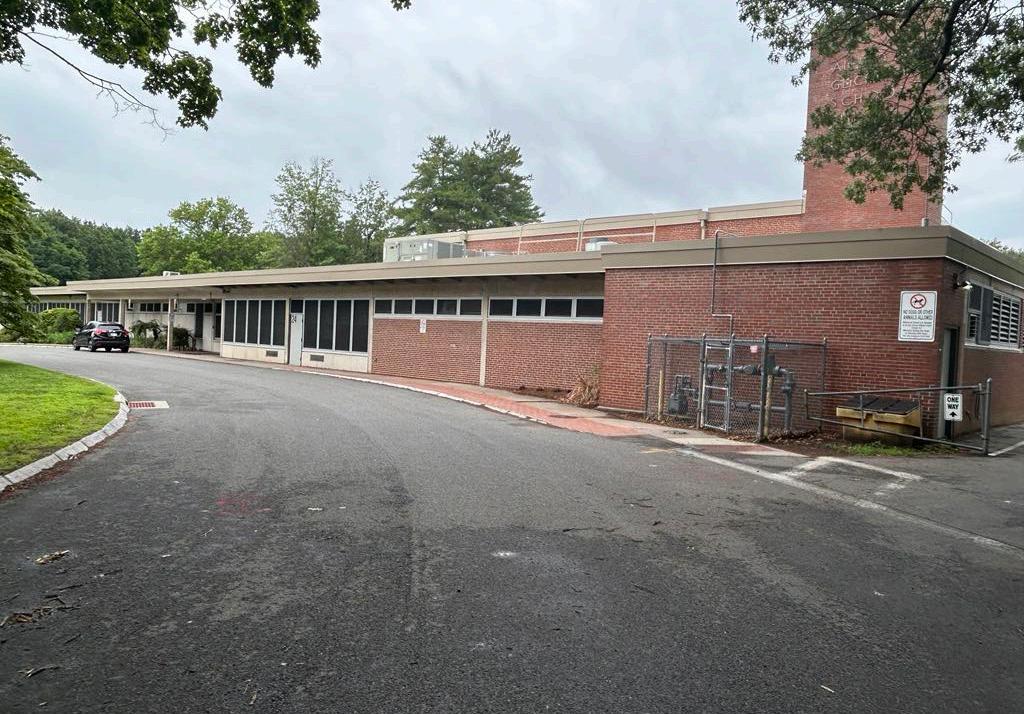
administrations on all available funding pipelines to support such work,” Ashe said.
In a statement about the Glickman money, Superintendent Sonia Dinnall touched on the collaborative work that made the grant possible.
“We are proud of our collaborative work to provide safe and healthy environments for our entire school community,” she
said. “Upgrading our HVAC systems demonstrates our commitment to a more sustainable future, and empowers our students by highlighting the importance of investing in their well-being and the environment.”
According to the grant announcement, Massachusetts Clean Energy Center is a state economic development agency dedicated to accelerating the
growth of the clean energy and climatetech sector across the state to spur job creation, deliver statewide environmental benefits, and secure long-term economic opportunities for the people of Massachusetts. Since 2010, MassCEC has awarded nearly $800 million in programs and investments and attracted more than $2.8 billion in private and public funds.
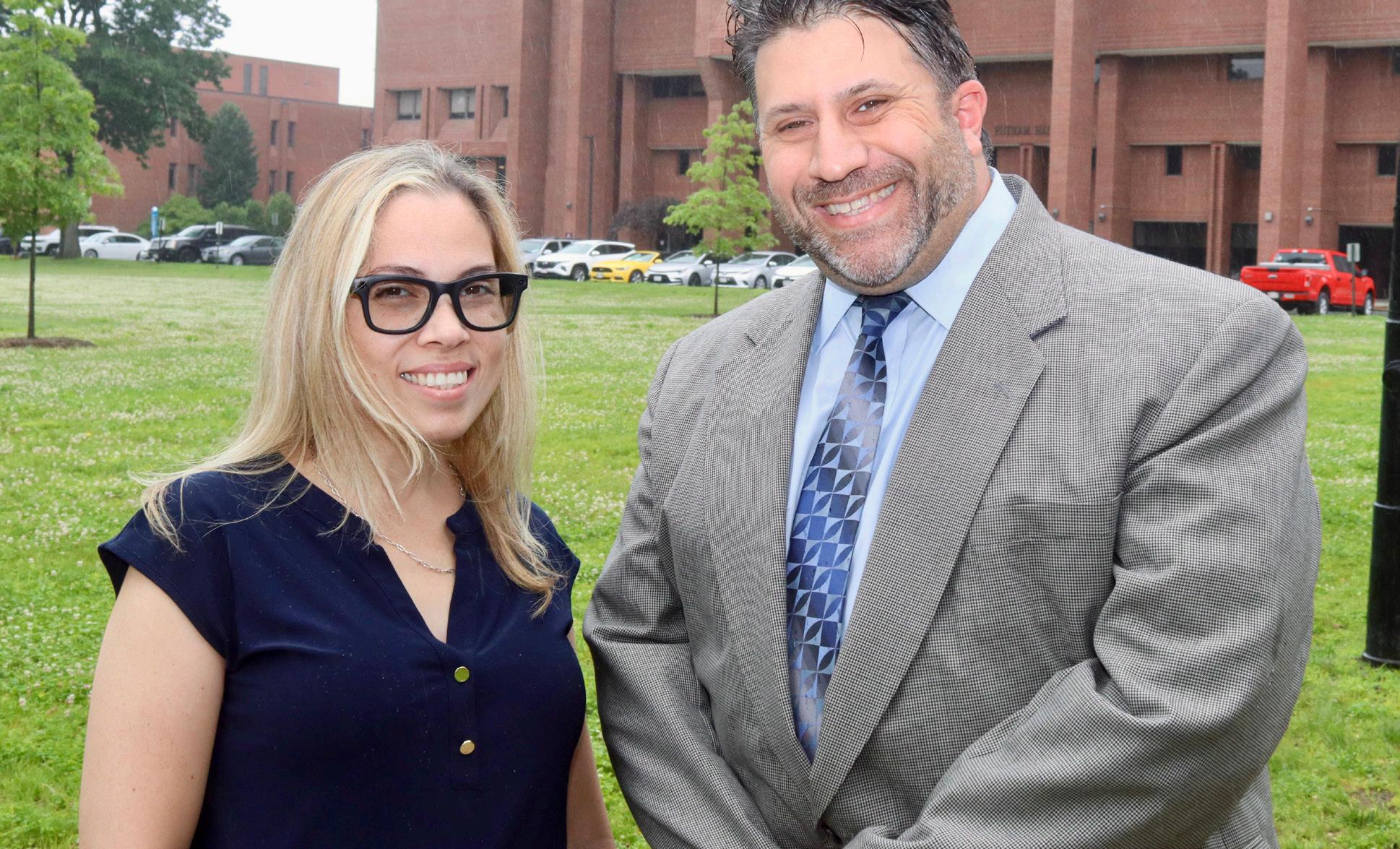
considering Rondinelli’s courses? “Go

SPRINGFIELD, MA
HOOPLANDIA

Hooplandia returned to the Eastern States Exposition for its third year and saw hundreds of teams come out to compete for bragging rights, trophies, and even cash for some divisions. The three-day event had clinics, food trucks, competitions, and entertainment for all ages.









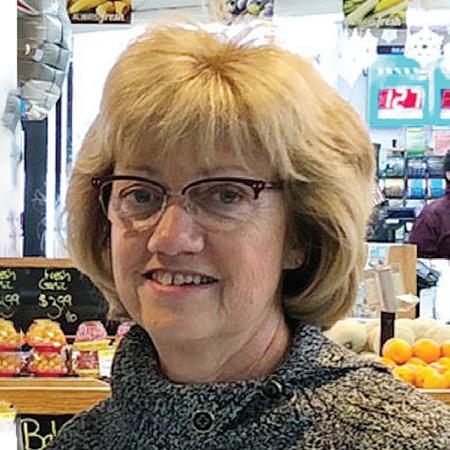
Judi LeBel
Big E’s Supermarket co-owner Judi LeBel continues to run the Easthampton business founded by her father in the 1970s.
Big E’s has served the greater Easthampton community since 1977 when LeBel’s father Ed Corbeil founded the location. LeBel said she remembers learning many valuable life lessons from her father, both in the house and in the supermarket, as she often saw firsthand his work in the community.
LeBel said while her dad ran a local business, being a grocer offered many overlaps in making bonds with the community and being an active leader within it. Not only was the operations of running a business a valuable education for LeBel, being a community partner and connecting with the public served showed community connection people are not always aware of.
“We’re very close to the people. Easthampton is great,” said LeBel.
Through the examples set by her father, LeBel learned what it means to not only be a business partner in the community, but also how to grow ties and relationships within. Since the business was turned over to her and now retired co-owner Michael Superson, LeBel said she has remembered these lessons and has maintained Big E’s role in being a community partner through and through.
Whether it is the straight operations of the grocery store or experience of what is required to also be present in your communtiy, LeBel said her father helped shaped her approach in it all.

“We try and support as much as we can whether it’s little league, sports, community events, churches, schools,” LeBel said.
Running the store just naturally leads to more face-to-face interaction and relationship building with customers, LeBel added, and said over time those connections only strengthen.
“I think being independent to a smaller store lets you cater more to customers, know who they are at a personal level and really try to fill that niche. Even with employees it’s not this strict rigor. We’re like a family,” LeBel said of the family business atmosphere.
Prior to getting in the family business, LeBel’s passion was teaching. She was a first grade teacher for a handful of years prior to her father purchasing another grocery store location in Westfield and looking to her if she would be interested in helping.
“I had to make a decision, go teach my little first graders or come help dad. So, I came to help dad,” LeBel shared. “It wasn’t easy because I loved teaching, but it was to help the family and get the front end going [at the new location] so I felt a responsibility.”
After the career change, LeBel was back with her father gaining the firsthand work and life experience that she would need when eventually taking over operations in 1997 and now alone for the past several years.
A core staple of the Easthampton community as a grocer and community leader, LeBel added she is thankful to be surrounded by the community she is in and to feel the connection she has with them through the services provided by Big E’s.
“It’s a great partnership. We would not be here without them so we try to do the best we can for them,” said LeBel of the Easthampton community. In celebration of Independent Retailer Month, Reminder Publishing is highlighting independent business owners in the Pioneer Valley who have made a positive impact and contributions to the community. For more, visit thereminder.com.
State shifting away from long effort to build reserves
By Colin A. Young State House News Service
BOSTON — The budget that lawmakers sent to Gov. Maura Healey’s desk on June 30 featured the latest signal that Beacon Hill is taking a different approach to the state’s rainy day savings account.
Rather than let hundreds of millions of dollars in capital gains tax revenue automatically inflate the planned deposit to the Stabilization Fund, the House and Senate agreed in the fiscal year 2026 budget passed on June 30 to instead use that money to take a bite out of the state’s unfunded pension liability. The Stabilization Fund is viewed by many officials as a barometer for the state’s fiscal responsibility and health. State government has preciously guarded the fund from even the suggestion of withdrawals and elected politicians routinely and loudly trumpet the fund’s high balance. The account is fed by earned interest, surplus revenue (when it exists) and capital gains tax revenue in excess of a set threshold.
Senate Ways and Means Chair Michael Rodrigues said that it’s been the capital gains tax revenue above that threshold that gets “just regularly and routinely deposited into the Stabilization Fund” that has allowed Beacon Hill to push the balance of the fund up to a balance of $8.165 billion as of June 2. The fund’s post-pandemic growth has been so significant that lawmakers opted in 2023 to raise a cap that could have constrained
further state saving and led to automatic tax rebates.
“Now that the Stabilization Fund is at this high balance, we’re looking at other long-term liabilities that are a hindrance for future budgets of the commonwealth, most notably our unfunded pension liability. So this budget conference report proposes to use $599 million from excess capital gains to pay down our unfunded pension liability, reducing this liability for years to come,” he said.
Once capital gains tax revenue surpasses a certain threshold (projected to be $1.66 billion in FY26), state laws calls for most of the excess (90%) to automatically go to the Stabilization Fund. The Pension Liability Fund is statutorily due 5% of the excess, as is a trust fund for other post-retiree benefits, also known as OPEB.
Lawmakers and governors have diverted so-called excess capital gains revenue before, including to balance the budget as recently as last year. Healey and the House this year proposed changing the distribution for FY26, instead directing 65% of the excess to the pension obligation, 20% to the rainy day fund, and 15% to OPEB.
But it was the Senate approach that prevailed through conference committee talks: 90% of excess capital gains to the pension liability, 5% to the Stabilization Fund and 5% to OPEB. That means about $600 million will go towards the pension liability, $33 million will go towards OPEB and $33 million will be deposited into the Stabilization Fund.
The most recent valuation report for the state’s total pension obligation, released in January, found an unfunded actuarial accrued liability of approximately $42.252 billion as of Jan. 1, 2024. Beacon Hill is working along a schedule to fully fund that pension liability by 2036, though it is legally required by 2040.
The revenue agreement that Rodrigues, House Ways and Means Chairman Aaron Michlewitz and Administration and Finance Secretary Matthew Gorzkowicz agreed to for FY26 calls for a $4.933 billion transfer to the state pension fund – $432 million more than in FY25. Rodrigues said the roughly $600 million in excess capital gains revenue would be part of, not a supplement to, the transfer already agreed to.
Senate Minority Leader Bruce Tarr, who said he and Rodrigues “share a concern about maintaining a healthy Stabilization Fund,” has raised concerns with the approach each time the budget has been before the Senate and in May called the idea “radical” and “risky.” The Gloucester Republican said June 30 that he would think that the same uncertainty that led Rodrigues and the House to reduce the budget’s bottom line would also highlight the value of a robust rainy day fund deposit.
“I would argue that given everything that he has described and the potential need to backfill — and I hesitate to use that term, but respond to — reductions in federal funding, to make anything less than a full contribution to
the Stabilization Fund, full being defined as what we have done in the past, I think, is in error,” Tarr said on June 30.
The FY25 budget called for $124.5 million in excess capital gains revenue to go to the Stabilization Fund, the FY24 budget called for $525 million, and the FY23 budget contemplated a deposit of nearly $1.4 billion in excess capital gains.
Rodrigues said in May that the $8.1 billion balance in the Stabilization Fund was “north of 15% of our operating budget,” a level that he described as “well beyond the gold standard” of credit rating agencies.
“My goal now is to get the commonwealth of Massachusetts to the highest bond rating possible, which is AAA. What’s the largest impediment to achieving AAA? Primarily the amount of indebtedness the commonwealth has,” Rodrigues said in May, specifically pointing to the state’s roughly $42 billion unfunded pension liability.
After previously drawing scrutiny from ratings agencies for dipping into the rainy day fund while the economy was growing, Beacon Hill spent the last handful of years working to build up a sizable nest egg and resisted calls to spend from its more than $8 billion balance.
But while withdrawals still aren’t favored, the budget’s latest diversion of revenue from the Stabilization Fund shows that lawmakers are warming up to different approaches to savings and long-term liabilities.
Lawmakers and the governor showed a similar willingness to forgo the maximization of growth in the Stabilization Fund with the FY25 budget Healey signed last July. That allowed the state to divert up to $375 million in excess capital gains tax revenue from the rainy-day pipeline and instead use it to balance the books for the cycle that ran from July 1, 2024 to June 30, 2025.
When it was time to close the books on FY24 this past December, Beacon Hill Democrats redirected more than half a billion dollars in capital gains revenue that would have been headed for the long-term savings account in order to close a budget shortfall and support some spending.
A law Healey signed in September lets her administration leverage up to $750 million in Stabilization Fund interest for grant-matching purposes through November 2026, as well as to pay down state debt. FY24’s interest earnings contributed $420.8 million to that new fund, a state financial report confirmed in February.
And by leaving themselves a roughly $800 million gap between the revenue forecast and projected spending in the FY26 budget, Beacon Hill Democrats have built in an additional layer of insulation for the Stabilization Fund. Meant to mitigate the impact of future tax revenue declines or federal funding changes, the wiggle room could give budget managers a cushion before they would have to turn to the Stabilization Fund in the event of a major downturn.


DINING ENTERTAINMENT
Summer offers myriad events in music, arts more
After their sold-out May 31 show “Dissecting the Beatles” at the Academy of Music, Bombyx resident company Young@Heart will take over the Sanctuary at Look Park on Tuesday, July 22, at 7 p.m., performing songs by artists ranging from Blur to The Beatles, and from Mavis Staples to Marianne Faithfull, taking you on a magical tour of some of their best music. All performers in Young@Heart range in age from 75 to 102.
For this performance, Y@H will be joined by Norma Dream, a band fronted by Norma Jean Haynes, the daughter of the late Chris Haynes, Y@H’s longtime accordion player.
Tickets to the July 22 Young@ Heart show can be purchased at https://tinyurl.com/24bex55k. Tickets are $20 in advance and $25 day-of. Discounted Card to Culture and student rates are available.
Art of Brewing Festival
The Norman Rockwell Museum in Stockbridge recently announce the return of its Art of
Brewing Festival for the seventh consecutive year on Saturday, Aug. 16, from 1-4 p.m., at the museum’s 36-acre campus.
The event will feature an exciting lineup of breweries, cideries, distilleries, wineries, and coffee purveyors from across the Northeast. Attendees, 21 and older, will receive 10 tasting tickets to sample a wide array of beverages — from crisp ciders to bold stouts — along with a free commemorative beer glass while supplies last. Tickets are $45 for non-members and $30 for museum members. For more information, visit tinyurl.com/358yp3s9.
52 Sumner adds shows
In addition to the dynamic performances already announced for this summer, two brand new shows have been added to the August lineup at 52 Sumner, Springfield’s live performance venue from Springfield Performing Arts Ventures, Inc. located at 52 Sumner Ave.
The new shows are:
• “It’s the Wildest,” a musical tribute to Louis Prima and
Keely Smith, on Friday, Aug. 8. Celebrate the high-energy, swingin’ sounds of in this spirited musical tribute. “It’s the Wildest” recreates the charisma, chemistry, and musical genius of the famed duo with timeless songs and an unforgettable performance.
• Blood Brothers: Mike Zito and Albert Castiglia, a bluesrock performance with special guests Peter Newland of FAT and Scott Murawski of Max Creek on Friday, Aug. 15. For tickets and showtimes, visit the Event Listing page on the 52 Sumner website. Follow 52 Sumner on Facebook and Instagram for the latest updates and announcements.
QAA Summer Exhibit
The Quabbin Art Association’s summer exhibit is now on display at the Hitchcock Center for the Environment at Hampshire College, 845 West St., Amherst. The exhibit will be on display through Aug. 28.
Writers Reading
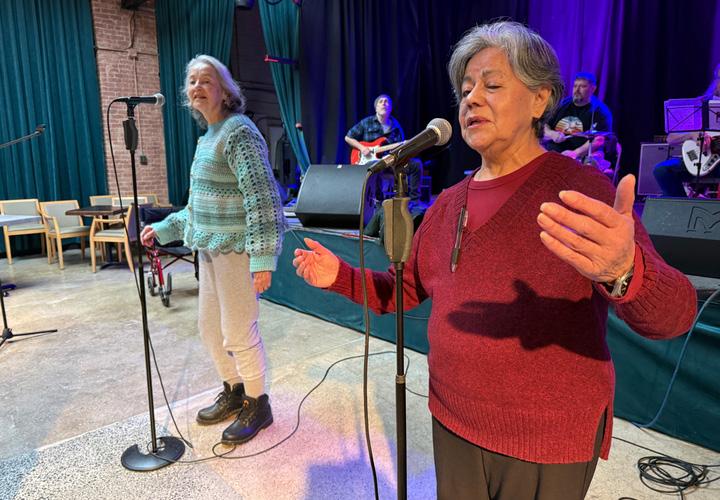
Writers Reading, a new author series, debuts on Thursday, July 10, at 7 p.m., presented by UMass Downtown in partnership with the Amherst Business Improvement District. Curated by poet
Hilltown 6 Pottery Tour returns for 19th year
By Trent Levakis tlevakis@thereminder.com
The Hilltown 6 Pottery Tour is returning for its 19th year later this month, offering another unique art experience.
On the last weekend of every July, the Hilltown 6 potters and their guest artists invite the Western Mass. community into their studios to witness ancient art in action during the Hilltown 6 Pottery Tour.
This year’s tour will be on Saturday and Sunday, July 26 and 27, from 10 a.m. to 5 p.m. each day. The tour is free and open to the public.
Potters will welcome attendees to watch as they showcase various techniques and materials with scheduled demonstrations and participatory events throughout both days. The artists will share how they shape earth into beautiful and distinct objects.
“The tour allows our guests to see the variety of functional ceramics being made right here in this community, in the fascinating settings where potters work,” said the Hilltown 6 in a joint statement about their history available on their website. “The itinerary offers an invitation to get out into some lovely backcountry – potters tend to thrive in secret hollows and on quirky hilltops.”
One of the original Hilltown 6 members, Mark Shapiro, told Reminder Publishing the tour was born almost two decades ago after he and other potters came together to brainstorm how they could recreate a local version of a popular pottery tour they learned of in Minnesota.
“We had been guest potters on that tour,” said Shapiro. “So, we saw that, and we saw how successful the tour was in Minnesota and we were kind of like well, what are we waiting for. Let’s take control of how our pots are seen and how the process of acquiring them happens. I think what’s really significant to me about that is people get the chance to experience the work where it’s made and meet the person who made it.”
During the tour, visitors will watch as clay artists craft teapots, vases, pitchers and more from start to finish. They will also see artists throw pots on a foot-powered treadle wheel, walk inside a giant wood-burning kiln, and taste fresh bread baked in a ceramic flameproof cloche.
“It’s a very different sense of consuming something whereas when you buy something that can
be made anywhere — do you know where your T-shirt is made, or who made it? So, it’s a fairly unique experience to use and acquire something that you actually go to the place where its made and you meet the person who actually made it with their own hands,” added Shapiro. “So that struck us all as a very powerful and a different model for how we could go forward in our careers and our lives.”
The Hilltown 6 Pottery Tour makes for a family-friendly weekend spent traversing the scenic hills that rise out of the Pioneer Valley and taking in all that the hilltowns have to offer. Happening during the peak of New England’s picturesque summer, visitors will also encounter farmstands and small businesses supplying the locally grown bounty of the season, from fresh eggs to homemade preserves, to artisanal brews.
The event has only grown over the years, added Shapiro, and they continue to work entirely as a cooperative organization. As popularity has grown, so have efforts to improve on the event and add to it. One example of a successful addition to the experience is the rolling demonstrations at each studio during the tour where people can see firsthand demonstrations on a pot or theme the artist is interested in.
“It’s another way of deepening the experience. You buy a pot, end up using it a few times. You remember, ‘Oh, I know how that was made. I saw how that was made.’
That changes the experience of owning and using and so that’s


been really great and I’m really happy that we’ve done that and it works really well,” said Shapiro.
This year, the Hilltown 6 is celebrating the event’s community spirit by donating a portion of each artist’s proceeds to the Food Bank of Western Massachusetts. Visitors to the 2025 pottery tour will not only get to experience the closeknit feel of the hilltowns and support local artists, but they will also help put food on the tables of those most in need.
Shapiro added that with the rise of food insecurity being felt in communities everywhere, raising funds in support of the Food Bank was a no brainer for the Hilltown 6.
“I feel like it’s a very positive response to the cuts that we’re seeing. We want to stand with people who are less fortunate than we are who might not have access to the kind of food security that we enjoy,” said Shapiro. “There’s also a natural thing about pots and food. We’re potters, we make pots for people to put their food on. It’s kind of natural association I think to want to support something like that because so much of our thinking is around how people eat and making that a positive cultural experience. Having a sense of abundance. So, anything we can do to support those institutions is very timely right now.”
With the combined beauty of handcrafted art and the Western Mass. landscape, it’s no secret that the tour has become a nationally recognized event. In past years, the event has drawn company from all corners of the state, as well as



New York, Boston, Hartford, Albany and beyond.
The Hilltown 6 is a group of now eight nationally renowned potters based in the Hilltowns all within 45 minutes of Northampton.
The group features Shapiro, Robbie Heidinger, Christy Knox, Maya Machin, Michael McCarthy, Hiroshi Nakayama, Constance Talbot and Sam Taylor. This year’s tour will also feature 18 guests from around the country.
For a complete demonstrations schedule, a map of studios, information on artists and more, visit hilltown6.com.
“What we do is we kind of make something from nothing. We take earth, or dirt, and we turn it into these useful and potentially beautiful things and that strikes me as a very if not noble, a certainly worthy endeavor at this moment,” said Shapiro.






zetti

EAST LONGMEADOW - HOOK DELIVERY
THURSDAY
144 Papers: St. Joseph Dr., Wisteria Ln., Tracey Ln., Pembroke Terr., Abbey Ln., Rockingham Cir., Dartmouth Ln., Partial - Prospect St., Chestnut St., Somers Rd.
124 Papers: Gerrard Ave., Holy Cross Cir., Kingston Ave., Lombard Ave., Mereline Ave., Nelson St., Roderick Ave., Partial- N. Main St.
LONGMEADOW - HOOK DELIVERY
THURSDAY
85 Papers: Williamsburg Dr., Eunice Dr., Tabor Crossing, Morgan Ridge, Burns Meadow, Churchill Dr., Partial - Converse St.
74 Papers: Canterbury Ln., Cobble Stone Rd., Inverness Ln., Partial - Wolf Swamp Rd.
93 Papers: Chandler Ave., Partial - Longmeadow St.
40 Papers: Laurel St. & Ln., Osceola Ln., Tecumseh Dr., Natanis Path
163 Papers: Albemarle Rd., Arcadia St., Barclay St., Chiswick St., Fairway Dr., Franklin Rd., Lincoln Pk. & Rd., Whitmun Rd., Woodmont Rd., Hillside Ter.
223 Papers: Benedict Terr., Birchwood Ave., Forest Glen Rd., Homecrest St., Roseland Terr., Partial- Laurel St.
113 Papers: Birnie Rd., Brookside Dr., Crescent Rd., Longview Dr., Partial- Longmeadow St.
70 Papers: Blokland Dr., Grassy Gutter Rd., Wilkin Dr., Woodside Dr., Woolworth St.
64 Papers: Magnolia Cir., Primrose Dr., Ridge Rd., Vanguard Ln., Partial- Merriweather Dr.



105 Papers: Brookwood Dr., Kenmore Dr., Knollwood Dr., Partial- Shaker Rd.
55 Papers: Bliss Rd.
99 Papers: Barbara Ln., Quinnehtuk Rd., Village Dr., Pioneer Dr., Partial-Maple Rd., Frank Smith Rd., Wolf Swamp Rd
79 Papers: Cross St., Fairfield Ter., Hawthorn St., Hopkins Pl.
91 Papers: Captain Rd., Caravelle Dr., Glenbrook Ln., Memery Ln., Pendelton Ln., Viscount Rd., Partial-Merriweather Dr.
87 Papers: Andover Rd., Ashford Rd., Cranwell Ln., Deerfield Ave., Willow Cir., Williston Dr., Willow Brook Rd., Partial-Frank Smith Rd.
149 Papers: Wyndward Rd., Woodland Rd., Eastland Rd., Hazardville Rd., Leetewood Dr., Maplewood St., Robin Rd., Prynnwood Rd., Prynne Ridge Rd., Wildwood


-Michael Beck









